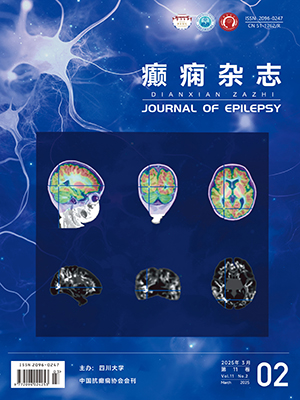| 1. |
Beghi E. The epidemiology of epilepsy. Neuroepidemiology, 2020, 54 (2): 185-191.
|
| 2. |
Katyayan A, Diaz-Medina G. Epilepsy: epileptic syndromes and treatment. Neurol Clin, 2021, 39 (3): 779-795.
|
| 3. |
Kanner AM, Bicchi MM. Antiseizure medications for adults with epilepsy: a review. JAMA, 2022, 327 (13): 1269-1281.
|
| 4. |
Gonzalez HFJ, Yengo-Kahn A, Englot DJ. Vagus nerve stimulation for the treatment of epilepsy. Neurosurg Clin N Am, 2019, 30 (2): 219-230.
|
| 5. |
Worrell GA. Electrical brain stimulation for epilepsy and emerging applications. J Clin Neurophysiol, 2021, 38 (6): 471-477.
|
| 6. |
Vassileva A, van Blooijs D, Leijten F, et al. Neocortical electrical stimulation for epilepsy: closed-loop versus open-loop. Epilepsy Res, 2018, 141: 95-101.
|
| 7. |
Yap JYY, Keatch C, Lambert E, et al. Critical review of transcutaneous vagus nerve stimulation: challenges for translation to clinical practice. Front Neurosci, 2020, 14: 284.
|
| 8. |
Alarcon G, Nawoor L, Valentin A. Electrical cortical stimulation: mapping for function and seizures. Neurosurg Clin N Am, 2020, 31 (3): 435-448.
|
| 9. |
Ohemeng KK, Parham K. Vagal Nerve Stimulation: indications, implantation, and outcomes. Otolaryngol Clin North Am, 2020, 53 (1): 127-143.
|
| 10. |
Ghasemi P, Sahraee T, Mohammadi A. Closed- and open-loop deep brain stimulation: methods, challenges, current and future aspects. J Biomed Phys Eng, 2018, 8 (2): 209-216.
|
| 11. |
Chang CW, Lee ST, Lim SN, et al. Electrical cortical stimulation for refractory focal epilepsy: a long-term follow-up study. Epilepsy Res, 2019, 151: 24-30.
|
| 12. |
Jarosiewicz B, Morrell M. The RNS system: brain-responsive neurostimulation for the treatment of epilepsy. Expert Rev Med Devices, 2021, 18 (2): 129-138.
|
| 13. |
Skarpaas TL, Jarosiewicz B, Morrell MJ. Brain-responsive neurostimulation for epilepsy (RNS ( (R)) System). Epilepsy Res, 2019, 153: 68-70.
|
| 14. |
Sun FT, Morrell MJ. The RNS System: responsive cortical stimulation for the treatment of refractory partial epilepsy. Expert Rev Med Devices, 2014, 11 (6): 563-572.
|
| 15. |
Bigelow MD, Kouzani AZ. Neural stimulation systems for the control of refractory epilepsy: a review. J Neuroeng Rehabil, 2019, 16 (1): 126.
|
| 16. |
Zhang H, Chen Y, Xie Y, et al. Closed-loop controller based on reference signal tracking for absence seizures. Sci Rep, 2022, 12 (1): 6730.
|
| 17. |
Musselman ED, Pelot NA, Grill WM. Empirically based guidelines for selecting vagus nerve stimulation parameters in epilepsy and heart failure. Cold Spring Harb Perspect Med, 2019, 9 (7).
|
| 18. |
Koeppen JA, Nahravani F, Kramer M, et al. Electrical stimulation of the anterior thalamus for epilepsy: clinical outcome and analysis of efficient target. Neuromodulation, 2019, 22 (4): 465-471.
|
| 19. |
Hescham S, Temel Y. Electrical stimulation of the fornix for the treatment of brain diseases. Handb Clin Neurol, 2021, 180: 447-454.
|
| 20. |
de Oliveira T, Cukiert A. Deep brain stimulation for treatment of refractory epilepsy. Neurol India, 2021, 69 (1): 42-44.
|
| 21. |
Kwon CS, Jette N, Ghatan S. Perspectives on the current developments with neuromodulation for the treatment of epilepsy. Expert Rev Neurother, 2020, 20 (2): 189-194.
|
| 22. |
Davis P, Gaitanis J. Neuromodulation for the treatment of epilepsy: a review of current approaches and future directions. Clin Ther, 2020, 42 (7): 1140-1154.
|
| 23. |
Lundstrom BN, Lin C, Starnes DK, et al. Safety and management of implanted epilepsy devices for imaging and surgery. Mayo Clin Proc, 2022, 97 (11): 2123-2138.
|
| 24. |
Takahashi Y, Enatsu R, Kanno A, et al. Comparison of thresholds between bipolar and monopolar electrical cortical stimulation. Neurol Med Chir (Tokyo), 2022, 62 (6): 294-299.
|
| 25. |
Gil-Lopez F, Boget T, Manzanares I, et al. External trigeminal nerve stimulation for drug resistant epilepsy: a randomized controlled trial. Brain Stimul, 2020, 13 (5): 1245-1253.
|
| 26. |
Ryvlin P, Rheims S, Hirsch LJ, et al. Neuromodulation in epilepsy: state-of-the-art approved therapies. Lancet Neurol, 2021, 20 (12): 1038-1047.
|
| 27. |
Richardson RM. Closed-loop brain stimulation and paradigm shifts in epilepsy surgery. Neurol Clin, 2022, 40 (2): 355-373.
|
| 28. |
Muthiah N, Akwayena E, Vodovotz L, et al. Comparison of traditional and closed loop vagus nerve stimulation for treatment of pediatric drug-resistant epilepsy: a propensity-matched retrospective cohort study. Seizure, 2022, 94: 74-81.
|
| 29. |
Haeusermann T, Lechner CR, Fong KC, et al. Closed-loop neuromodulation and self-perception in clinical treatment of refractory epilepsy. AJOB Neurosci, 2023, 14 (1): 32-44.
|
| 30. |
Winston GM, Guadix S, Lavieri MT, et al. Closed-loop vagal nerve stimulation for intractable epilepsy: a single-center experience. Seizure, 2021, 88: 95-101.
|
| 31. |
Dumpelmann M. Early seizure detection for closed loop direct neurostimulation devices in epilepsy. J Neural Eng, 2019, 16 (4): 041001.
|
| 32. |
Opie NL, O'Brien TJ. The potential of closed-loop endovascular neurostimulation as a viable therapeutic approach for drug-resistant epilepsy: a critical review. Artif Organs, 2022, 46 (3): 337-348.
|
| 33. |
Tzadok M, Harush A, Nissenkorn A, et al. Clinical outcomes of closed-loop vagal nerve stimulation in patients with refractory epilepsy. Seizure, 2019, 71: 140-144.
|
| 34. |
Ge Y, Cao Y, Yi G, et al. Robust closed-loop control of spike-and-wave discharges in a thalamocortical computational model of absence epilepsy. Sci Rep, 2019, 9 (1): 9093.
|
| 35. |
Schulze-Bonhage A. Long-term outcome in neurostimulation of epilepsy. Epilepsy Behav, 2019, 91: 25-29.
|
| 36. |
Matias CM, Sharan A, Wu C. Responsive neurostimulation for the treatment of epilepsy. Neurosurg Clin N Am, 2019, 30 (2): 231-242.
|
| 37. |
Inaji M, Yamamoto T, Kawai K, et al. Responsive neurostimulation as a novel palliative option in epilepsy surgery. Neurol Med Chir (Tokyo), 2021, 61 (1): 1-11.
|
| 38. |
Xue T, Chen S, Bai Y, et al. Neuromodulation in drug-resistant epilepsy: a review of current knowledge. Acta Neurol Scand, 2022, 146 (6): 786-797.
|
| 39. |
Li MCH, Cook MJ. Deep brain stimulation for drug-resistant epilepsy. Epilepsia, 2018, 59 (2): 273-290.
|




